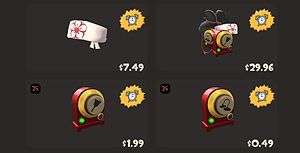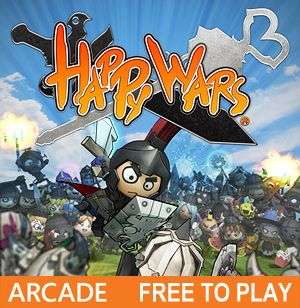The Future is Free (To Play)
by Adam B

"I know, it's ridiculous isn't it?"
Many years ago, before the world had descended into economic chaos and a dog had been lauded as the most talented person in Britain, there was a well-established business model for games – companies would make a game and then sell it to customers for money. Every so often, somebody would stand up in a meeting and say “Why don’t we just give our game away to people for free instead?”, at which point everyone else would look embarrassed and pretend not to know them. Then, towards the end of the atrociously-named “naughties”, several failing MMOs decided that, with nothing to lose apart from more money, they might as well go against the prevailing opinion of their games, those that they “couldn’t give away”, and try giving them away.
This move, with games such as LOTR: Online, Age of Conan and Champions Online going free to play, created the somewhat-unwanted association between the model and failed games, with any announcement of free to play elements being seen as an admission that the game was on its way out. Nobody was really surprised when making these MMOs free to play increased their player numbers, but what was surprising was that it actually increased their revenues as well. Publishers soon came to realise what most people already knew – that it is much easier to get someone to spend £20/month in 10 £2 chunks spread over a period of weeks than it is to get them to spend £10/month in 1 £10 chunk, because people are bad with numbers.
Most early free-to-play games offered players a simple proposition: ‘You can play our game for free, but if you pay us money then you’ll get all kinds of shinies that will let you pwn everybody else’. Unsurprisingly, many gamers were less than enthusiastic about the idea of these Pay-To-Win systems as they discriminated strongly against people who weren’t willing or able to pay for the best gear. As more games began to embrace free-to-play, new models emerged to supplant Pay-To-Win, with in-game stores offering cosmetic items, sponsorships and advertising providing revenue, and freemium systems (hybrid free/pay models which evoke memories of the old shareware days) becoming more and more common.
 Despite the success of many free to play games, a lot of people were still sceptical that people would be willing to pay money on a semi-regular basis for cosmetic items without any real gameplay benefits on a large enough scale to make it profitable. Then, in 2011, Valve switched Team Fortress 2 to a free-to-play model and started selling in-game hats, making more money in twelve months than they had from the previous four years of retail sales of the game.
Despite the success of many free to play games, a lot of people were still sceptical that people would be willing to pay money on a semi-regular basis for cosmetic items without any real gameplay benefits on a large enough scale to make it profitable. Then, in 2011, Valve switched Team Fortress 2 to a free-to-play model and started selling in-game hats, making more money in twelve months than they had from the previous four years of retail sales of the game.
 Of course, in all this discussion of free-to-play games, we may have overlooked one tiny segment of the market – consoles. One of the big factors in the success of free to play on the PC, outside of Facebook games, which rarely directly impact the “mainstream” games industry, was the availability of digital distribution as a primary means of obtaining games; no boxed copies means no manufacturing overhead, no shipping costs, no breakage and no stock left gathering dust on shelves. Although digital distribution on consoles has come on leaps and bounds in the last few years, it is still a way behind the PC in general and, frankly, laughable compared to Steam, preventing publishers from really pushing the free-to-play model into peoples living rooms. That said, there are a number of developers currently working on free-to-play games destined for console platforms, and this is only going increase as the next generation of hardware moves ever closer while Sony and Microsoft make it easier to distribute full games via their online services without an up-front cost.
Of course, in all this discussion of free-to-play games, we may have overlooked one tiny segment of the market – consoles. One of the big factors in the success of free to play on the PC, outside of Facebook games, which rarely directly impact the “mainstream” games industry, was the availability of digital distribution as a primary means of obtaining games; no boxed copies means no manufacturing overhead, no shipping costs, no breakage and no stock left gathering dust on shelves. Although digital distribution on consoles has come on leaps and bounds in the last few years, it is still a way behind the PC in general and, frankly, laughable compared to Steam, preventing publishers from really pushing the free-to-play model into peoples living rooms. That said, there are a number of developers currently working on free-to-play games destined for console platforms, and this is only going increase as the next generation of hardware moves ever closer while Sony and Microsoft make it easier to distribute full games via their online services without an up-front cost.
With major developers like Crytek recently announcing a shift towards an entirely free to play release strategy, Valve releasing Dota 2 in the same “play for free, pay for hats” model as TF2 and even the big MMO players such as WoW and SWtOR flirting with freemium models, it seems as though non-free game releases may soon be a niche market, restricted to only the triplest of triple-A titles and the indiest of indies, but is that what we really want?
Even without the concerns attached to Pay-To-Win models, there is still a worry that free-to-play games will lead to segmented player bases, with those willing (and able) to pay having access to more content and features, leaving those who can’t or won’t as second-class citizens unable to participate on the same level. It is also a double-edged sword in terms of player population for multiplayer games and MMOs; on the one hand the fact that the game doesn’t have a cost associated with it removes the biggest barrier to acquiring new players, especially given the current economic climate, but on the other, if players haven’t made any significant financial investment in the game then they are less likely to stay with it when a shiny new free game appears and, of course, a smaller player population makes it harder to attract new players to the game and keep existing ones.
 Moreover, it potentially allows game makers to dramatically extend their current moneymaking DLC system by essentially giving away a free basic game and then charging players piecemeal for what they would ordinarily receive in a retail product with a much higher total cost than the £30 or £40 they would normally have paid. Relying on publishers not to cynically exploit the way the human mind works to increase their profits is naïve at best. Countering this is that the free model does encourage developers to continue to support their games after release, something that is often severely lacking at the moment, with revenue being an ongoing trickle over months or years rather than a big chunk over launch week. Retaining players by fixing bugs and adding content becomes far more important than it once was.
Moreover, it potentially allows game makers to dramatically extend their current moneymaking DLC system by essentially giving away a free basic game and then charging players piecemeal for what they would ordinarily receive in a retail product with a much higher total cost than the £30 or £40 they would normally have paid. Relying on publishers not to cynically exploit the way the human mind works to increase their profits is naïve at best. Countering this is that the free model does encourage developers to continue to support their games after release, something that is often severely lacking at the moment, with revenue being an ongoing trickle over months or years rather than a big chunk over launch week. Retaining players by fixing bugs and adding content becomes far more important than it once was.
Ultimately, the free-to-play model is not going anywhere in the near future; it’s currently undergoing a massive growth phase as it expands into new genres and platforms and, so far, has been known more for its big successes than grand failures. How it develops over the next few years will depend greatly on how it is embraced or abused by players, developers, and publishers alike; there is a careful balance to be struck between the industry’s desire for money and the willingness of players to pay for things that they may feel they should get as standard. Personally, I have no real interest in paying for vanity items or buying £40 worth of content for a free game instead of just buying a £30 game in the first place, but then there are numerous people out there who paid actual money for the Oblivion Horse Armour DLC, so apparently it is possible to get people to pay for anything.
Last five articles by Adam B
- Deus Ex: Mankind Divided - Review
- No Man's Sky - Review
- The Curious Tale of The Consoles That Became PCs
- Quality of Life
- Why You Should Be Watching Dota 2 Right Now





















It’s funny; the first E3 we went to had maybe three or four invitations to meet with devs/publishers to discuss their upcoming Free-To-Play MMO but there weren’t really very many on the whole. By the time Gamescom came around, only a couple of months later, we had more on the list… but this year… holy shit… for every “regular” invitation we got, we got another for a Free-To-Play MMO. It’s incredible how, over the period of perhaps a year, the F2P model has just sky-rocketed.
To be honest, I’m seriously considering playing End of Nations when it releases. Mainly because I hate what EA have done with the Command & Conquer franchise and this looks like it’ll claw back some of that genre, for me at least. Until now, the only things you have to pay for are skins for your troops and it’s not really something that I’m bothered about so it SHOULD remain a free game for me.
One game that I played which was apparently free was on the Vita. Can’t remember what it was called, but it was listed as being free and so I expected that it would be ad-supported like a lot of apps on Android or iPhone, but no… it was a Bejewelled-type game where after a certain period of time it paused and you had to wait something like a week for more credit to keep playing OR pay them some money to immediately unlock it. That’s the sort of F2P model that I would never have any interest in. Really you’re just subscribing to the ability to play a game which, if you ask me, means it’s not actually free. Free means that the game can be played for free and IF you choose to enhance it with paid add-ons then so be it, but paying to continue playing means it isn’t free.
It’s certainly a very interesting route for the gaming industry as a whole, and I’m keen to see where we end up with it though. Imagine if Bethesda announced that Fallout: Croydon was going F2P but you could pay for certain weapons and armour… I’d likely pay more than I would had I bought a full-price game. I’m an idiot like that though.